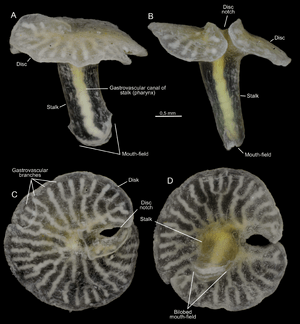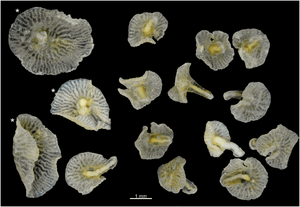Dendrogramma facts for kids
Quick facts for kids Dendrogramma |
|
|---|---|
 |
|
| Dendrogramma enigmatica | |
| Scientific classification |
|
| Kingdom: | Animalia |
| Phylum: | Cnidaria |
| Class: | Hydrozoa |
| Order: | Siphonophorae |
| Family: | Rhodaliidae |
| Genus: | Dendrogramma Just, Kristensen, & Olesen, 2014 |
| Type species | |
| Dendrogramma enigmatica Just, Kristensen, & Olesen, 2014
|
|
| Species | |
|
|
Dendrogramma enigmatica is a unique type of siphonophore, which is a group of ocean animals that live in colonies. It's the only known species in its group. Scientists first described it in 2014. They studied its shape and features from samples collected way back in 1986.
At first, scientists weren't sure where Dendrogramma fit in the animal family tree. But in 2016, new studies using DNA helped identify it as a siphonophore. Scientists believe the samples they found are actually just parts (called bracts) of a larger siphonophore. The full animal hasn't been found yet!
Contents
How Dendrogramma Was Found
The first Dendrogramma samples were collected in 1986. This happened during a science trip off the coast of south-east Australia. Researchers found them deep in the ocean, about 400 to 1000 meters (1,300 to 3,300 feet) down. They used a special sled dragged along the sea floor to collect animals living there.
The scientists were amazed by how unusual these 18 samples looked. They preserved them in chemicals like formaldehyde and ethanol for later study. When they went back to the same spot in 1988, they couldn't find any more. It took until 2014 for them to finally publish their discovery. Jean Just, one of the scientists, said it took so long because the discovery was so extraordinary. They needed a lot of time to study, read, and talk to others to be sure they had found something truly special.
When Dendrogramma was first found, its place in the animal kingdom was a mystery. Scientists even thought about putting it in its own major animal group, called a phylum. But they decided to wait for more information. Jørgen Olesen, another lead scientist, thought it might be an early branch on the tree of life. He noted it looked similar to ancient creatures from 600 million years ago, like the Ediacara fauna. Some Ediacaran creatures had a disc shape with branching channels inside, much like Dendrogramma. This idea caused a lot of excitement!
However, the original samples couldn't be used for DNA testing. The way they were preserved didn't keep the DNA intact. Because of its mysterious nature, the International Institute for Species Exploration named Dendrogramma one of the "Top 10 New Species" discovered in 2014.
Then, in late 2015, another expedition found 85 more samples of Dendrogramma. This time, they collected them in a way that allowed for genetic analysis. This helped solve the mystery of where Dendrogramma belongs.
What Its Name Means
The name Dendrogramma comes from two ancient Greek words:
This name refers to the branching pattern of its internal canals, which look like a dendrogram. Biologists use dendrograms as tree-like diagrams to show how different organisms are related.
The specific name enigmatica means "mysterious." This was chosen because the creatures were so puzzling to scientists. Another name, discoides, referred to the disc-like shape of some of the animals. However, scientists later realized that D. discoides was just a different form of D. enigmatica.
What Dendrogramma Looks Like
The first samples of Dendrogramma looked a bit like mushrooms. They had a flat, somewhat round disc and a stalk. What was thought to be a mouth was at the end of the stalk, surrounded by small flaps. This "mouth" led to what seemed to be a digestive canal that branched out many times inside the disc.
These creatures have an outer skin. Inside, there's a jelly-like layer called mesoglea, which separates the skin from what was believed to be a stomach. The stalks can be up to 8 millimeters (about 0.3 inches) long. The discs range from 11 to 17 millimeters (about 0.4 to 0.7 inches) across.
Initially, scientists thought there were two species. They called them D. discoides and D. enigmatica. They mainly differed in the shape of the disc and the length of the stalk. D. discoides had a full disc and a shorter stalk. D. enigmatica had a notched disc and a longer stalk. But later, it was found that these were just different forms of the same species.
Even though they were first thought to be free-living animals, scientists now believe these samples are just detached parts, or bracts, of a larger siphonophore colony. The full siphonophore animal has not yet been found.
Where Dendrogramma Fits In
Dendrogramma has a body plan that reminds scientists of animals like Cnidaria (like jellyfish and corals) and Ctenophora (comb jellies). However, the Dendrogramma samples don't have the stinging cells that cnidarians have. They also don't have the tentacles that comb jellies are known for.
By studying their DNA, scientists found that Dendrogramma is related to a group of siphonophores called Rhodaliidae. More specifically, it seems closely related to members of families like Agalmatidae, Abylidae, and Prayidae.
See also
 In Spanish: Dendrogramma para niños
In Spanish: Dendrogramma para niños


